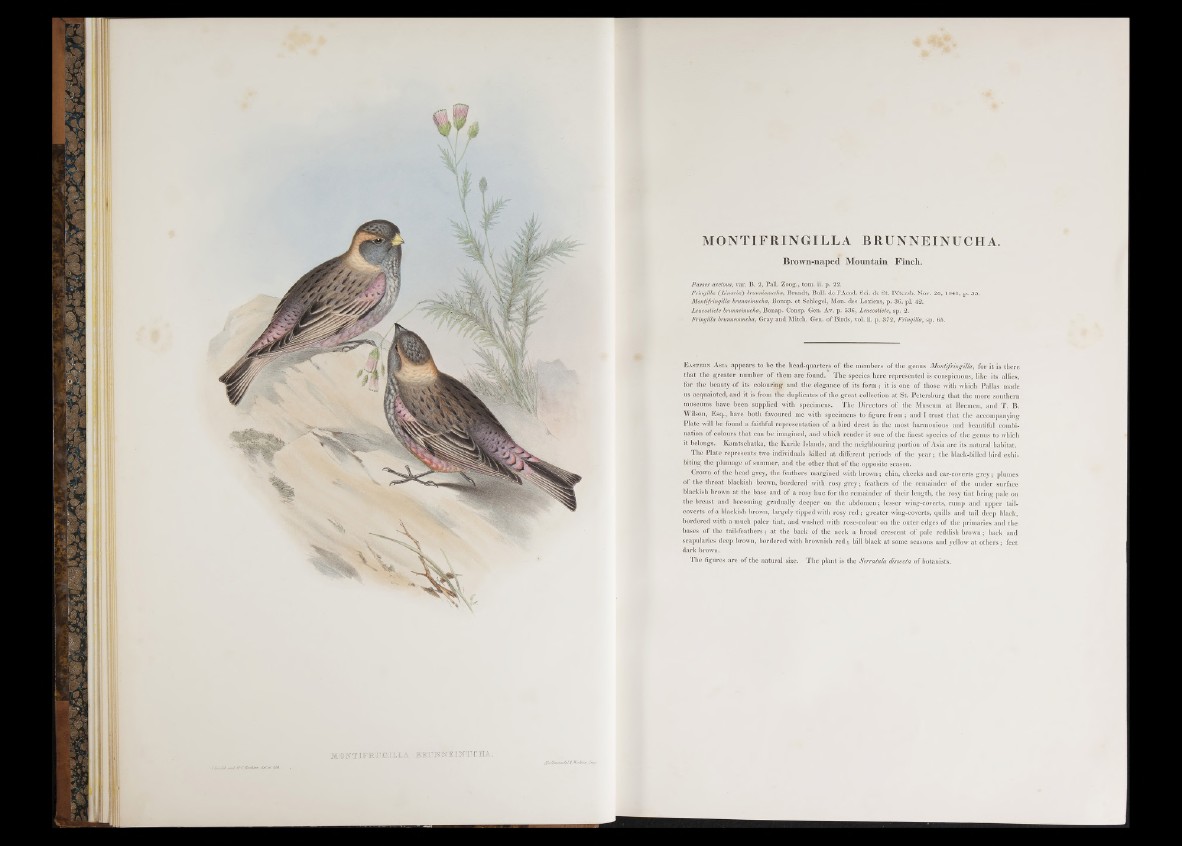
M 0 S T I F M . t r n j n . t 4 ■ B M U N S E lS t JC M A .
MONTIFRINGILLA BRUNNEINUCHA.
Brown-naped Mountain Finch.
Passer arctous, var. B. 2, Pall. Zoog., tom. ii. p. 22.
Fringilla ( Linaria) brunnionucha, Brandt, Bull, de l’Acad. Sci. de St. Pétersb. Nov. 26, 1841, p. 35.
Montifringilla brunneinucha, Bonap. e t Schlegel, Mon. des Loxiens, p. 36. pi. 42.
Leucosticte brmneinucha, Bonap. Consp. Gen. Av. p. 536, Leucosticte, sp. 2.
Fringilla brunneonucha, Gray and Mitch. Gen. of B irds, vol. ii. p. 372, Fringilla, sp. 65.
E a s t e r n A s i a appears to be the head-quarters o f the members of the genus Montifringilla, for it is there
that the greater number of them are founds The species here represented is conspicuous, like its allies,
for the beauty o f its colouring and the elegance of its form; it is one of those with which Pallas made
us acquainted, and it is from the duplicates o f the great collection at St. Petersburg that the more southern
museums have been supplied' with specimens. The Directors of the Museum a t Bremen, and T. B.
Wilson, Esq., have both favoured me with specimens to figure from; and I trust that the accompanying
Plate will be found a faithful representation of a bird drest in the most harmonious and beautiful combination
of colours that can be imagined, and which render it one of the finest species of the genus to which
it belongs. Kamtschatka, the Kurile Islands, and the neighbouring portion of Asia are its natural habitat.
The Plate represents two individuals killed at different periods of the y e a r; the black-billed bird exhibiting
the plumage of summer, and the other that of the opposite season.
Crown of the head grey, the feathers margined with brown; chin, cheeks and ear-coverts g rey ; plumes
o f the throat blackish brown, bordered with rosy g rey ; feathers of the remainder of the under surface
blackish brown at the base and o f a rosy hue for the remainder of their length, the rosy tint being pale on
the breast and becoming gradually deeper on the abdomen; lesser wing-coverts, rump and upper tail-
coverts o f a blackish brown, largely tipped with rosy r e d ; greater wing-coverts, quills and tail deep black,
bordered with a much paler tint, and washed with rose-colour on the outer edges of the primaries and the
bases of the tail-feathers; at the back of the neck a broad crescent o f pale reddish brown; back and
scapularies deep brown, bordered with brownish r e d ; bill black at some seasons and yellow at o th ers ; feet
dark brown.
The figures are of the natural size. The plant is the Serratula dissecta of botanists.